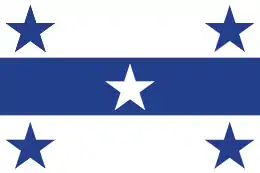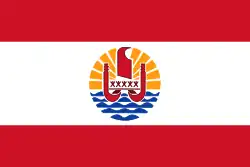 Flag of the Gambier Islands | |
| Proportion | 2:3 |
|---|---|
| Adopted | 1837 |
| Design | Three horizontal stripes of equal width in the order white-blue-white charged with a blue star in each corner and a white star in the middle. |
| Designed by | Armand Mauruc |
The Flag of the Gambier Islands is the flag of the Gambier Islands of French Polynesia in the Pacific Ocean, administered by France. It was created in 1832 and adopted in 1837.[1][2]
Description
The flag of the Gambier Islands is divided into three horizontal bands, with white on the top and bottom and blue in the middle. There is a blue five-pointed star in each of the four corners and one white five-pointed star in the center. Each of the stars represent one of the major islands in the group, with the blue stars representing Mangareva, Taravai, Aukena, and Akamaru, and the white star representing the islet Temoe, which is geographically distant from the others.[2] The blue represents the sea while the white represents purity, and evangelism.[3] The blue and white may also relate to the distinctive color of the local churches.
The flag was originally described as "sky blue," but the ruling party of French Polynesia has declared azure the official color. This is likely because sky blue is associated with the opposition party and independence movement.[4]
History

Conflict between Chile and Peru in the early 1830s disrupted trade in the Pacific. A mother-of-pearl trader named Armand Mauruc was flying under a Chilean flag but, wishing to avoid conflict, requested King Maputeoa adopt the Gambier national flag, which he did.[1][5] Mauruc is sometimes credited as the creator, but French explorer Jules Dumont d'Urville likely designed the flag for the island of Mangareva some years before it was adopted for the Gambier Islands.[1]
The flag was used for the Gambier Islands until 1844, when the islands were placed under French protectorate and the French tricolor became its official symbol. The French flag remained the only official symbol of the Gambier Islands until 4 December 1985 when the government ruled flags of the archipelagos and islands could flown next to the national and territorial flag.[6]
References
- 1 2 3 Cuzent, Gilbert (1872). Voyage aux îles Gambier (Archipel de Mangarèva). Paris: V. Masson et Fils. p. 38.
- 1 2 "LE PAYS, SON PEUPLE ET SA CULTURE - LE GOUVERNEMENT - PRESENTATION DU PAYS". 2009-03-05. Archived from the original on 5 March 2009. Retrieved 2022-09-18.
- ↑ "Drapeau de l'archipel des îles Gambier". emblemes.free.fr. Retrieved 2022-09-18.
- ↑ TH, admin (2017-08-05). "Drapeau des Gambier, bleu azur ou bleu outremer ?". Tahiti Heritage (in French). Retrieved 2022-09-18.
- ↑ Juan Manuel Gabino Villascán, Santiago Dotor & Ivan Sache, 28 August 2005
- ↑ "Arrêté n° 1196 CM du 4 décembre 1985 réglementant l'apposition et l'exposition de drapeaux, pavillons et emblèmes le long des voies publiques et sur les bâtiments administratifs, édifices et monuments de service public". emblemes.free.fr. Retrieved 2022-09-18.

